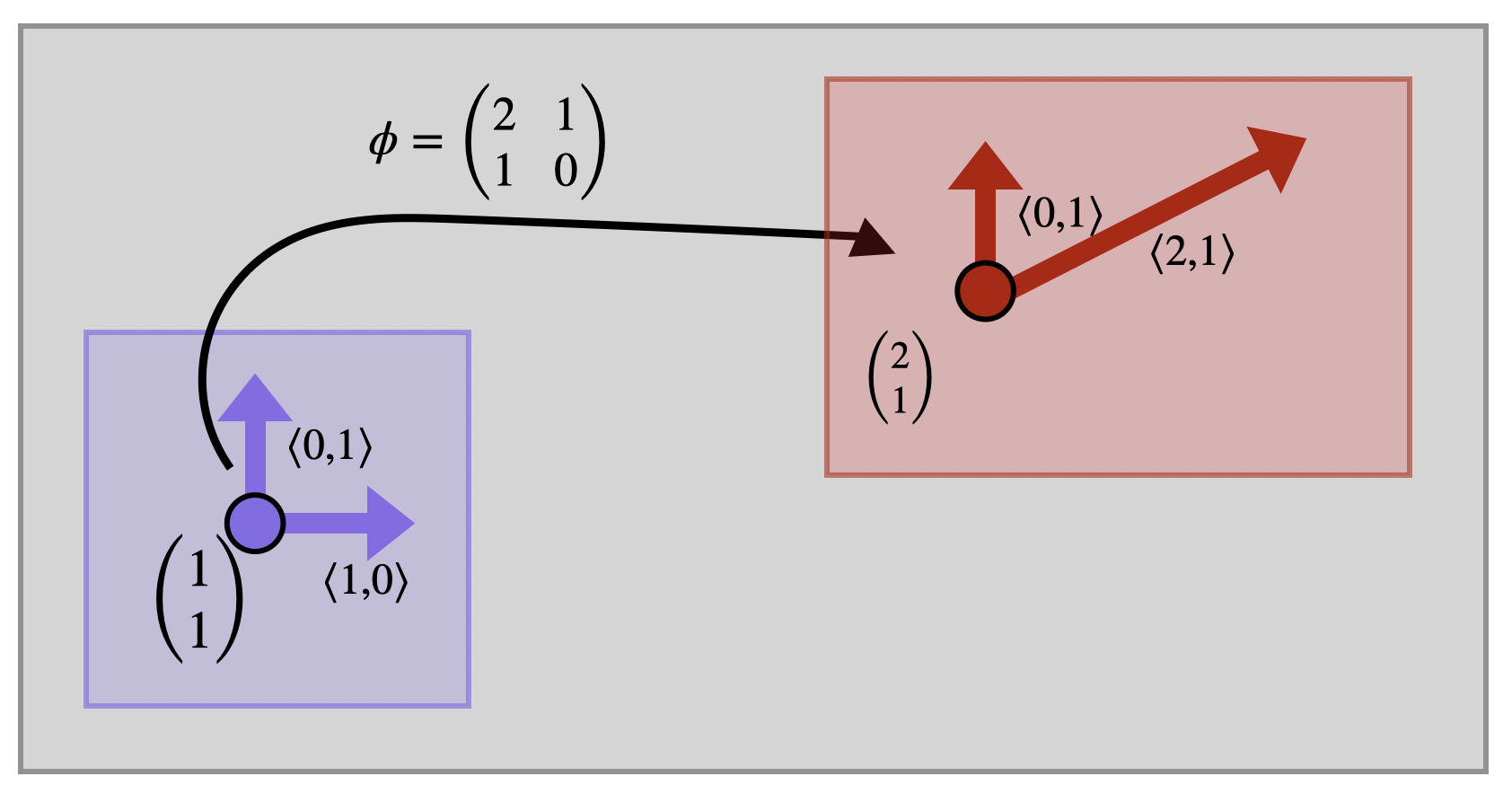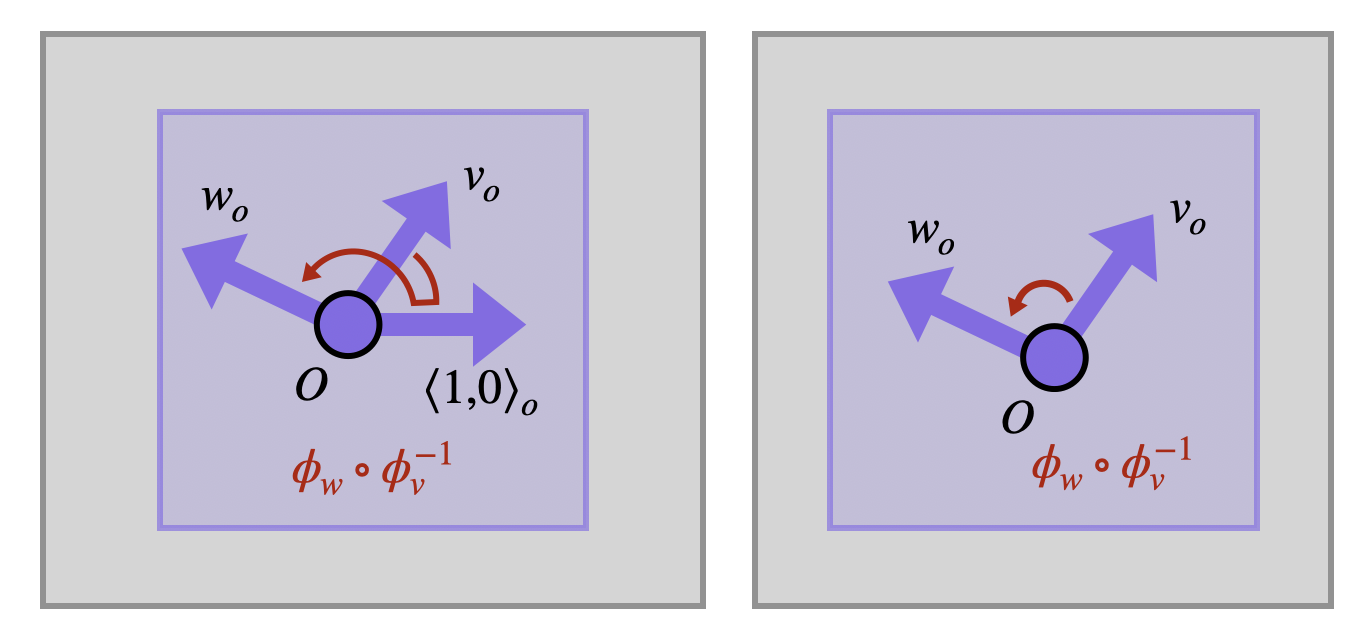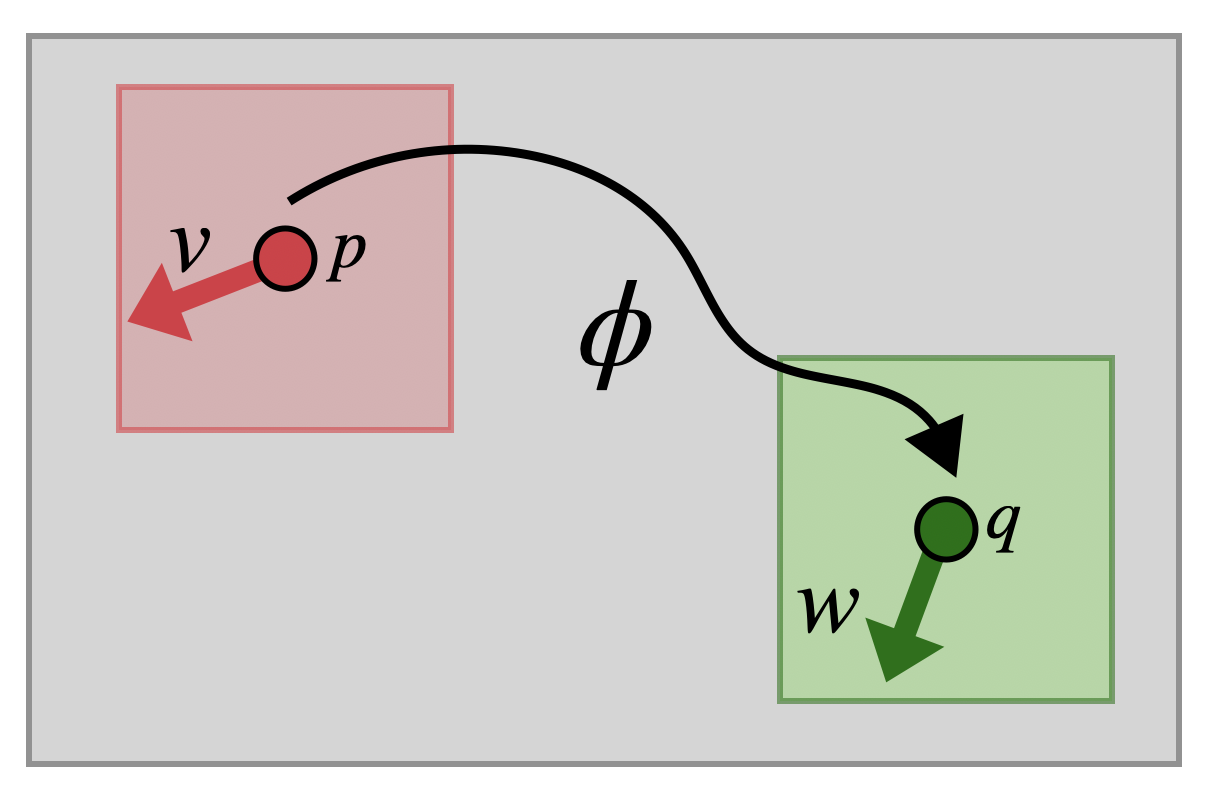Besides measuring distance, one of the other most fundamental notions to geometry is that of an isometry, or a rigid motion of space. This comes from greek meaning same-measure, as an isometry is a function that does not change lengths.
Definition 11.1 (Isometries in ) An isometry of is a function which preserves all infinitesimal lengths of .
What does it mean to preserve infinitesimal lengths? If is a vector (an infinitesimal segment of a curve), then while takes to a new point , infinitesimally it acts as a linear transformation from to . That infinitesimal linear transformation is the derivative matrix , which takes the original vector to . What we are interested in is whether or not changed the length of .
Definition 11.2 A function preserves infinitesimal lengths if for every and every , we have
Using this condition, one can show with some calculus that every isometry is actually an invertible function: that means, if is an isometry there is a function which undoes the action of . We will not prove this theorem here (as it is purely a result of advanced calculus, and doesn’t help us learn geometry). If you like, you can think of this as an extra condition we are assuming* about isometries in this course.
Theorem 11.1 (Isometries are Invertible Functions)
Just as one can apply an isometry to points, one can apply it to an entire curve by composition: if is a curve, the curve can be thought of as drawing , and then performing whatever action specifies.
Theorem 11.2 (Isometries Preserve Lengths of Curves) Let be an isometry, and a curve. Then
Proof. Let be an isometry, and be a curve. Then we know the length of itself is defined as , and we wish to compare this with the length of
To compute this integral we need to first differentiate using the chain rule: Where here recall that is a matrix - the linear transformation recording the infinitesimal behavior of at a point - and is a tangent vector - an infinitesimal piece of arc. Since we have assumed that is an isometry, it preserves infinitesimal lengths by definition so Using this, we can simplify our integral:
In fact, the converse of this is true as well: if a differentiable function preserves the lengths of all curves, then it preserves infinitesimal lengths, and is an isometry.
Translations & Some Rotations
We will go more in-depth in our discussion of isometries later on, but for now it’s good practice with the definition to find a couple examples that we can use.
Theorem 11.3 (Translations are Isometries) If is a fixed vector, a translation by of is given by the function , or, in coordinates, . This is an isometry of .
Proof. Here we need to compute the derivative of : Since we get the matrix
This is the identity matrix which means it does nothing to vectors: if is any vector based at then
Thus, since did not change anything at all about it did not change its length and so is an isometry.
A particularly nice collection of functions to work with are the linear maps . One of the nicest properties of these they are easy to differentiate: recall that if is a matrix representing the linear map then is the same matrix! So, if we are looking for linear isometries we can save ourselves the work of differentiation.
Example 11.1 The following linear map is an isometry of
Proof. We check that this preserves all infinitesimal lengths. Denote by the matrix , then is the linear map , so its derivative is given by the same linear map, at every point .
Thus, to see that is an isometry, all we need to do is check whether or not the length of is the same as the length of for an arbitrary vector .
As these lengths are the same, is an isometry.
Of course, not all linear maps are isometries: its easy to cook up something that doesn’t preserve infinitesimal lengths.
Example 11.2 The following linear map is not an isometry of :
Proof. Since is linear, is equal to the same linear map at each point of . To prove is not an isometry, all we need to do is find one vector which has its length changed by . Consider the vector based at . Then
While had unit length has length , so does not preserve all infinitesimal lengths, and therefore is not an isometry.
What are the conditions on a linear map being an isometry? Well, if it needs to preserve all infinitesimal lengths, it needs to send the unit vector to some other unit vector, and same for . Since the image of these vectors are the first and second columns of the matrix representing them, this means that every linear isometry has a matrix whose rows are unit vectors. Is every such matrix an isometry?
Exercise 11.1 Write down a linear map that sends both and to unit vectors, but is not an isometry.
However, if we choose unit vectors correctly, we do get an linear isometry! Intuitively from our previous experience with the plane we know what to should happen, we are looking for a rotation! The theorem below confirms that rotations about in the plane exist: you can fix that point, and perform an isometry that moves to any other unit tangent vector in .
Theorem 11.4 Let be an arbitrary unit vector based at in . Then there exists an isometry of which takes fixes and takes to . Such an isometry is called a rotation about .
Proof. Let be a unit vector. Then the vector is a rotated copy of by 90 degrees. From these, we can build a linear map which sends to (and also to ):
Now we check this is an isometry. Let be an arbitrary point in and be an arbitrary tangent vector based at . We need to see that . Since is a linear transformation, we know that it is its own derivative, so
And so we can apply without much trouble to :
Calculating the length is now just a matter of algebra, using the fact that is a unit vector so . After simplifying, we see
Thus the infinitesimal length of was not changed by the transformation , and as were arbitrary this is true for all infinitesimal lengths - is an isometry.
Exercise 11.2 Check the calculation that is skipped in the proof above actually works out as claimed.
Creating Isometries: Conjugation
Some additional exercises to explore deeper the idea of isometries, and practice the chain rule!
Exercise 11.3 (Composition of Isometries) If and are two isometries of , then the composition is also an isometry.
Exercise 11.4 (Inversion of Isometries) If is an isometry of , then its inverse function is also an isometry.
Together these say that the isometries of a space form a group. Being able to compose and invert isometries is quite useful when you need to create an isometry that does a specific task out of a limited set of pieces.
As a first example, suppose you wanted to show there is a rotation about that takes some unit vector to another unit vector . So far we only have one theorem about rotations - Theorem 11.4, which tells us that we can find one taking to any vector. We will need to create two of these, and combine them via composition and inversion:
Proposition 11.1 For any two unit vectors , there is a Euclidean isometry which fixes and sends to .
Proof. Let be a rotation taking to , and be an rotation taking to : both of these are linear, and exist by Theorem 11.4. Now, consider the inverse function . This is an isometry (by Exercise 11.4) which undoes the action of , so it fixes and takes to .
Now consider the composition . This is a composition of isometries, and hence an isometry (Exercise 20). It fixes since does and does, so all we need to see is that it takes to . So, just follow the vector ! We first feed it into , which takes it to , and then we feed the result into , which takes to !
If you wanted to write this in symbols instead of pictures or words, it looks like this:
Next, we will look at trying to build an isometry that rotates around an arbitrary point in the plane. We already found the isometries that rotate around : they are the nice linear maps of Theorem 11.4. But tracking down isometries that rotate around other points of the plane sounds more difficult. First of all - they cannot be linear maps! A linear map fixes the point , but a rotation about the point fixes….! However, combining a translation taking to zero with a rotation about zero in the right way, we can succeed!
Theorem 11.5 Let be a point in the Euclidean plane and a tangent vector based at . Then there is an isometry of which fixes , and takes to .
Proof. Let be the translation : this is an isometry by Theorem 11.3, and it takes to . Also, let be the rotation about which takes the vector based at to the vector based at (Recall means a vector with the same coordinates as , but based at instead of .
From these, we construct the map . This is an isometry because its a composition of isometries and their inverses (Exercise 20,Exercise 11.4), so we just need to check that it does what is claimed.
This fixes the point : since takes to , its inverse takes to . Then fixes , and finally, takes back to :
Next, we nee to check it does what we claim to the tangent vectors. To do so, we need to take the derivative of at , and see that it takes to . In symbols, we want to show .
We know by the proof of Theorem 11.3 that the derivative of is the identity matrix. Thus, the derivative of is also the identity matrix (we differentiate an inverse by using the inverse of the derivative matrix, by Theorem 8.1). So applying at to leaves it unchanged, except it moves the basepoint to (since ).
Next, we apply . This fixes , and by Theorem 11.4 we know takes to . Finally, we apply : since its derivative is the identity matrix it does not affect the coordinates of any vector just the basepoint, so it takes to .
In symbols:
Exercise 11.5 Can you modify the argument of Theorem 11.5 above to prove that in fact for any point and any two unit tangent vectors , in , there is an isometry which fixes and takes to ?
Hint: look at the proof of Proposition 11.1 for inspiration.
This operation - move, then do your next trick, then undo the original movement is an extremely common manuever in mathematics to build new things from known things. Its essential not only in geometry, but also at the heart of abstract algebra and other fields, and is called conjugation.
Definition 11.3 (Conjugation) If and are two mathematical objects that can be multiplied or composed, then the object is called the conjugate of by .
Often, we will interpret this as doing the action determined by , at the location determined by . Thus we can describe the previous theorem much more succinctly with our new terminology: to rotate about the point , we conjugate a rotation about by a translation from to . Or - we perform a rotation at the location we translate to.
Homogenity and Isotropy
The fundamental property of Euclidean geometry that allowed the greeks and ancients to make so much progress was the incredible amount of symmetry that the plane has. It doesn’t matter where you draw a triangle, a circle or another figure: all locations of the plane look and act the same. This concept that space looks the same at every point and also behaves the same in every direction is fundamental to modern geometry
Definition 11.4 (Homogeneous Space) A space is homogeneous if for every pair of points in the space, there is an isometry taking one to the other.
Definition 11.5 (Isotropic Space) A space is isotropic if for any point and any two directions leaving , there is a rotation of the space taking one direction to the other.
The existence of translations shows us that the Euclidean plane is homogeneous, while the ability to rotate about any point shows us that it is isotropic.
Theorem 11.6 (Euclidean space is Homogeneous and Isotropic)
In practice, we will use the homogenity and isotropy of Euclidean space to simplify a lot of arguments. Once we prove something is true at one location (like the origin, where calculation is simple) we will immediately be able to deduce that the analogous theorem is true at all other points of the plane! To make such arguments, its useful to repackage homogenity and isotropy into a useful tool.
Proposition 11.2 (Moving from to .) Given any two pairs and of points in Euclidean space and unit tangent vectors , based at them, there exists an isometry taking to .
Exercise 11.6 Prove Proposition 11.2 above.
Hint: use Theorem 11.3 to construct isometries taking to both and , and Proposition 11.1 to build the right sort of rotation around that you need. Compose these (or their inverses) to get a map taking to , then to , and finally to .
Similarities
Isometries - maps that preserve all infinitesimal lengths - are very special among the collection of all possible maps of the plane. Most mappings don’t do anything understandable to lengths!
However, there is one important intermediate ground of maps: they don’t preserve distances - but they don’t change them arbitrarily either. We will call a map a similarity if it scales all infinitesimal lengths by the same factor:
Definition 11.6 An map is called a similarity if there is a positive real number such that for all tangent vectors . This constant is called the scaling factor or dilation of the map .
Perhaps the simplest similarities of the plane are given by vector scalar multiplication: just take the map .
Example 11.3 The map is a similarity with scaling factor . Computing its derivative we see and so for any point and any vector applying just multiplies all its coordinates by . Thus if , Since this is the same constant for every vector , this implies that is a similarity!K
Because similarities do exactly the same thing to every tangent vector in the plane, we can compute exactly how they scale the lengths of curves.
Proposition 11.3 (Similarities Scale Lengths) Let be a curve, and a similarity with scaling factor . Then
Proof. We compute the length of via an integral: Where in the middle we used the fact that was a similarity so for any vector .
Just like for isometries, we have as a theorem of calculus that this condition actually implies that our map is invertible! We will not prove this theorem here, and if you like you can instead treat this as an extra condition we require of a function to be a similarity.
Theorem 11.7 (Every Similarity is Invertible)
For isometries, you proved the inverse of an isometry is an isometry (Exercise 11.4) by showing that if didn’t change the length of any vectors, than neither could . Here we investigate the analogous question for similarities.
Proposition 11.4 If is a similarity with scaling factor , then is also a similarity, this time with scaling factor .
Proof. Let be such a similarity, and be its inverse. Then by definition we know their composition is the identity function $ The identity function has the identity matrix as its derivative. On the other side, we can use the multivariable chain rule to get
Now start with any vector based at a point . We first feed this vector into , which returns a new vector - let’s call it . We don’t know anything about at the moment, but we do know that when we feed it into , its length will multiply by , since is a similarity. But we know more than this! The end result must be literally the vector : since we started with and the composition of with is the identity matrix.
Thus we know that whatever is, when you multiply its length by you get the length of , so But - remember is just the vector : so we’ve found And this holds for all vectors - so the inverse is indeed a similarity, and the scaling constant is .
More generally, we can use the same sort of reasoning to understand compositions of any similarities.
Exercise 11.7 Prove that the composition of a similarity and isometry is another similarity, with the same scaling factor.
Exercise 11.8 If and are two similarities with scaling constants and respectively, the composition is also a similarity, with scaling constant .
From this, we can build many more similarities from the simple ones we know.
Exercise 11.9 The similarities fix in the plane: can you use translations to build a similarity with scaling constant which instead fixes the point ?










